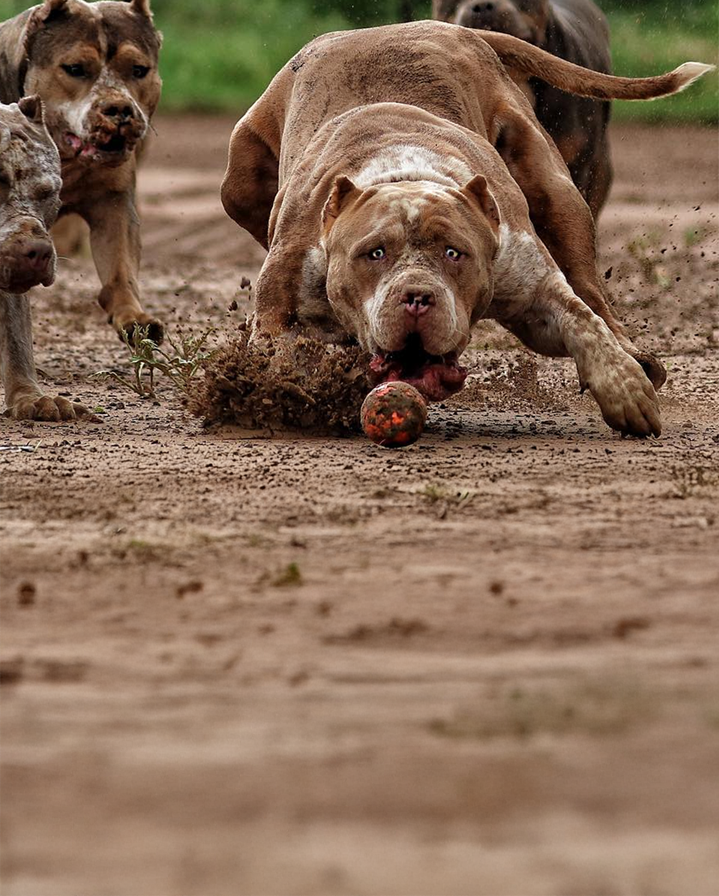How to Break Up a Dog Fight and How to Prevent Them
Pit bulls are a loyal and loving breed of dog with countless good qualities. And as a proud owner of this wonderful breed, it’s your responsibility to keep your dog—and other dogs in the area—safe and happy.
In order to do that, it’s important to take the proper steps to prevent dog fights.
In the right circumstances, all dogs will fight. But pit bulls fights can be more frequent and more severe if you don’t know how to prevent them.
A dog fight might sound scary, but the truth is that you can easily prevent them by making a few smart decisions. And if a fight does break out, you can break it up quickly as long as you know what to expect and how to react.
A Few Things You Need to Understand About Pit Bulls
- Pit bulls were bred for fighting. This doesn’t make them mean, bad, or evil; it’s just their heritage (similar to how many other dogs are bred for hunting).
- Other dog breeds will act out submission signals when they want to stop fighting, which usually signals the end of the fight. But pit bulls may ignore these signals, which means that a pit bull fight can lead to serious damage—or worse—if the fight is not broken up.
- Pit bulls are “people” dogs. They love spending time with people and enjoy attention and love from your family. They do not need another dog around to be happy.
What Causes Dogs to Fight?
- Dog fights can happen suddenly and without warning. Fights may be preceded by growling, barking, or posturing, but they may not be. Fights can even occur between dogs that have been close friends for years. And once two dogs have fought before, they are more likely to fight again in the future.
- Fights can be triggered by seemingly innocent causes, such as excitement and stimulation from seeing a squirrel or other small animal run by. Fights can also escalate from rough-housing, competing over a toy, or even out of jealousy (for example, if one dog is getting more attention from the family).
- Sexual hormones can cause dogs to behave much more aggressively than normal.
- Finally, tension between dogs can cause them to fight. And one sure source of tension is an unclear pecking order. If you have a fighting breed of dog, make sure to train it properly so that it clearly understands its place in the social hierarchy.
How to Prevent Dog Fights
The #1 best way to prevent dog fights in your home is to make the pit bull your only pet. As we mentioned above, pit bulls are “people dogs” who enjoy spending time with your family and do not need another dog to be happy.
If there’s no other dog around, there’s no one for your pit bull to fight with.
If you prefer to have more than one dog, here are 8 tips to minimize any chance of fighting:
- Get one male and one female. Same-sex dogs are more likely to fight. Two males (or two females) are much more likely to fight than a male and a female. This is true of every breed, not just pit bulls, because two dogs of the same sex are likely to see each other as rivals.
- Release pent-up energy by exercising your dogs. If dogs are not exercised frequently enough, they will build pent-up energy. This can lead to dog fights.
- Walk your dogs together. Walking your dogs together forms a stronger pack. Dogs that have formed a strong pack are less likely to fight.
- Spay or neuter your pit bulls as early as possible. Sexual hormones cause them to be much more aggressive than usual.
- Never leave your pit bull unsupervised with other animals. If you aren’t around to watch them, each pit bull should be crated or kept in a separate room.
- Watch your dogs when they are playing. Even innocent rough-housing can escalate into a fight if you aren’t paying attention. Remember, as the human you are the leader of the pack—it’s your job to set limits on the dogs’ behavior.
- Pick up dog toys, bones, and food when they’re not being used. Two dogs who stumble across a toy or a bone could start fighting over it.
- Always keep your pit bull on a leash when you take them for a walk, and keep them away from other unleashed dogs. This means that you should NEVER bring an adult pit bull to an off-leash dog park.
What If A Fight Does Break Out?
If your dog does start fighting, it’s important not to panic. Screaming and panicking will not stop a fight, it will only intensify it. By staying calming and using the proper tools, you can break up the fight quickly.
How to break up a dog fight, Method 1:
The two things you will need are a break stick (to pry the dog’s mouth open) and a collar or leash (to pull the dogs apart). It's important to keep collars on your dogs at all times. Breaking up a dog fight is more difficult when the dogs are not wearing collars.
A break stick is a stick you insert between the dog’s back teeth. Then, twist the stick to pry the dog’s mouth open.
Once the dog’s mouth is open and the hold is broken, grab their collars or leashes and pull UP. Avoid pulling them apart face to face at ground level, it will only make them fight more intensely. Separate the dogs as quickly as you can—by putting them in separate rooms, or tying one to a tree while you remove the other.
How to break up a dog fight, Method 2:
One of the FASTEST and SAFEST way to break up a dog fight is by grabbing both dogs by their collars and holding them in in the air as high as possible, so the dogs lose oxygen. Without oxygen, they will not be able to hold their grip.
Yes, one dog will usually lose oxygen before the other, but as long as both dog's front feet are off the ground and the collar is applying direct pressure to bottom of neck (as high up on neck as possible) they WILL lose oxygen and release their grip.
Do not hold the dogs in the air ANY longer than necessary — and that is the moment the dog releases its grip.
NEVER scold or hit your dog after a fight. Speak quietly to the dog to sooth it and reduce the arousal level. After the fight is over, it's important that you create peace, harmony, and balance.
The idea of a dog fight might sound scary, but as long as you follow this advice you shouldn’t have anything to worry about. Just be mindful of your dog’s heritage, and you’ll have a loving family member who will be a source of happiness for years to come.









138 comments
My oldest pit was injured tore his acl so we have had him in the room for a couple weeks so it can heal…now him and our other pit fights every time they see eachouther . I want to know how we can break them fighting so intencly as we do not want to give up one of them . I need suggestions asap!!!
I don’t take re-homing a dog lightly, but I think this is one of those situations where if you can find a good, responsible home for the pup, it would be best for everyone. See if a local rescue will help you post the pup and process applications for him so he goes to a good home.
I ᕼᗩᗪ TᗯO ᑭᑌᑭᑭY’ᔕ ᗩᑎᗪ TᕼEY ᗯEᖇE ᗷOTᕼ ᖴEᗰᗩᒪE ᗷᑌT TᕼEY ᗪIᗪ ᑎOT GET IᑎTO ᗩ ᖴIGᕼT ᗯITᕼ Eᗩᑕᕼ OTᕼEᖇ ᗯᗩᔕ TᕼᗩT ᗷEᑕᗩᑌᔕE TᕼEY ᗯEᖇE YOᑌᑎG Oᖇ ᗷEᑕᗩᑌᔕE TᕼEY ᗯEᖇE ᔕIᔕTEᖇᔕ?ᗩᒪᔕO ᑭᒪEᗩᔕE KEEᑭ
YOᑌᖇ ᗪOG Oᑎ ᗩ ᒪEᗩᔕᕼ EᐯEᑎ Iᖴ IT Iᔕ TᖇᗩIᑎEᗪ
Pit bulls were not bred for fighting. You are so ignorant. Do your research before you write any articles. Didn’t want to read further
My family and I have two pit-bull mixes (from the same litter) and they both have been getting into fights. Previously it has been over an object; stick, toy, chickens etc. But just yesterday, they began fighting while they were roaming our yard, and the previous day they had gotten into a fight as well. It was a harmless game of tackle until it wasn’t. We really don’t know what is making these fights happen, and it is killing us to always to be attentive and weary when our dogs are around each other. Is this a problem with dominance from my family’s part? Or is it lack of knowing for my dogs and where they stand in the pack?